Customer service representatives are the first point of contact for your company or business. They handle the real-life issues raised by users and are required to respond quickly and efficiently to resolve queries. This is where your company’s reputation is at stake and a positive impression can be created or lost.
Even with a quality product, good UX/UI, and strong SEO, a misaligned and untrained customer support team can derail the user’s engagement with your service. A well-trained and aligned team is what keeps users coming back.
But no worries, here in this blog post, we have compiled a to-do list for your customer service department. From discussing customer support principles to proven tips, you’ll get a compact guide here.
So without further ado, let’s jump in and learn how to speed up your customer service.
What are the principles of providing quality customer support? Real facts to know
Before we share the customer service principles, first of all, let’s learn about what they are.
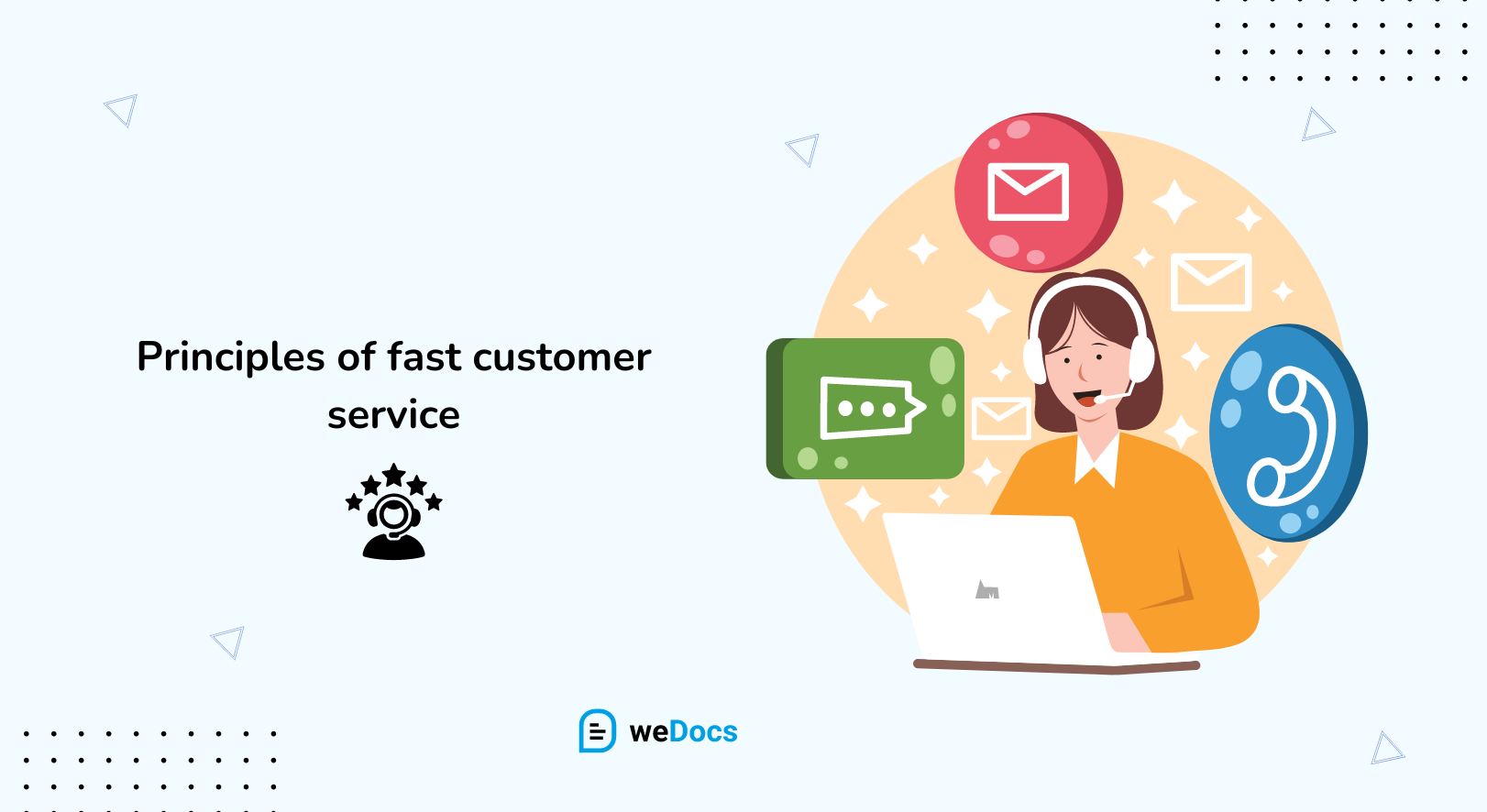
Customer service principles are the core guidelines that shape how a business interacts with its customers to provide a positive and helpful experience. These principles aim to build trust, resolve issues efficiently, and ultimately keep customers satisfied and loyal.
In today’s fast-paced world, customers tend to do more quick activities than before. Activities mean searching for the products, visiting websites, checking reviews, and purchasing them based on the previous record. When all of these are considered, customer service is also an important factor that customers prioritize. But how?
Yes, a good product means there are a lot of things happening behind the scenes. It includes great plans, executions, customer satisfaction, paid campaigns, product demonstrations, and good customer support.
Users will reach out to your customer support section first, whether they buy your product or not. They’re probably just checking out or querying the product’s ins and outs. So this is the time when your customer service principles can be a great weapon.
Here are five major principles that motivate you to provide fast customer service:
1. Customer-focused service
Quality customer support prioritizes understanding the customer. Representatives actively listen to concerns, ask clarifying questions, and acknowledge emotions. The goal is to go beyond the surface-level issue and address the underlying needs and frustrations of the customer. This approach can lead to more effective solutions and a more positive experience.
2. Communication is the main goal
Clear and accurate communication is essential. Information should be easy to understand, free of technical jargon, and delivered in plain language. Transparency and honesty are key, even when delivering bad news. By avoiding false promises and being upfront, customer support builds trust and allows customers to make informed decisions.
3. Empathy and respect
Quality customer support representatives show empathy by putting themselves in the customer’s shoes and acknowledging their situation. This helps diffuse frustration and build connections. Respectful communication is equally important. Treat every customer with courtesy, avoid interruptions, and actively listen to their concerns.
4. Quick and efficient replies
Customers don’t want to wait. Quality customer support aims for prompt and accurate resolution. In some cases, empowering customers with self-service options or tools to resolve issues themselves can be beneficial. This can include providing clear instructions, FAQs, or online knowledge bases.
5. Continuous learning
Customer feedback is crucial. Quality customer support systems actively seek feedback through surveys, reviews, or direct communication. This allows them to identify areas for improvement and adapt their approach. Investing in ongoing training and development for representatives ensures they have the knowledge and skills to handle complex situations and new products or services.
Apart from these main things, there must be some other factors to check. But if you can implement and adapt these qualities in your customer support, you’ll see a magical result.
Why fast customer service is vital to the success of your business
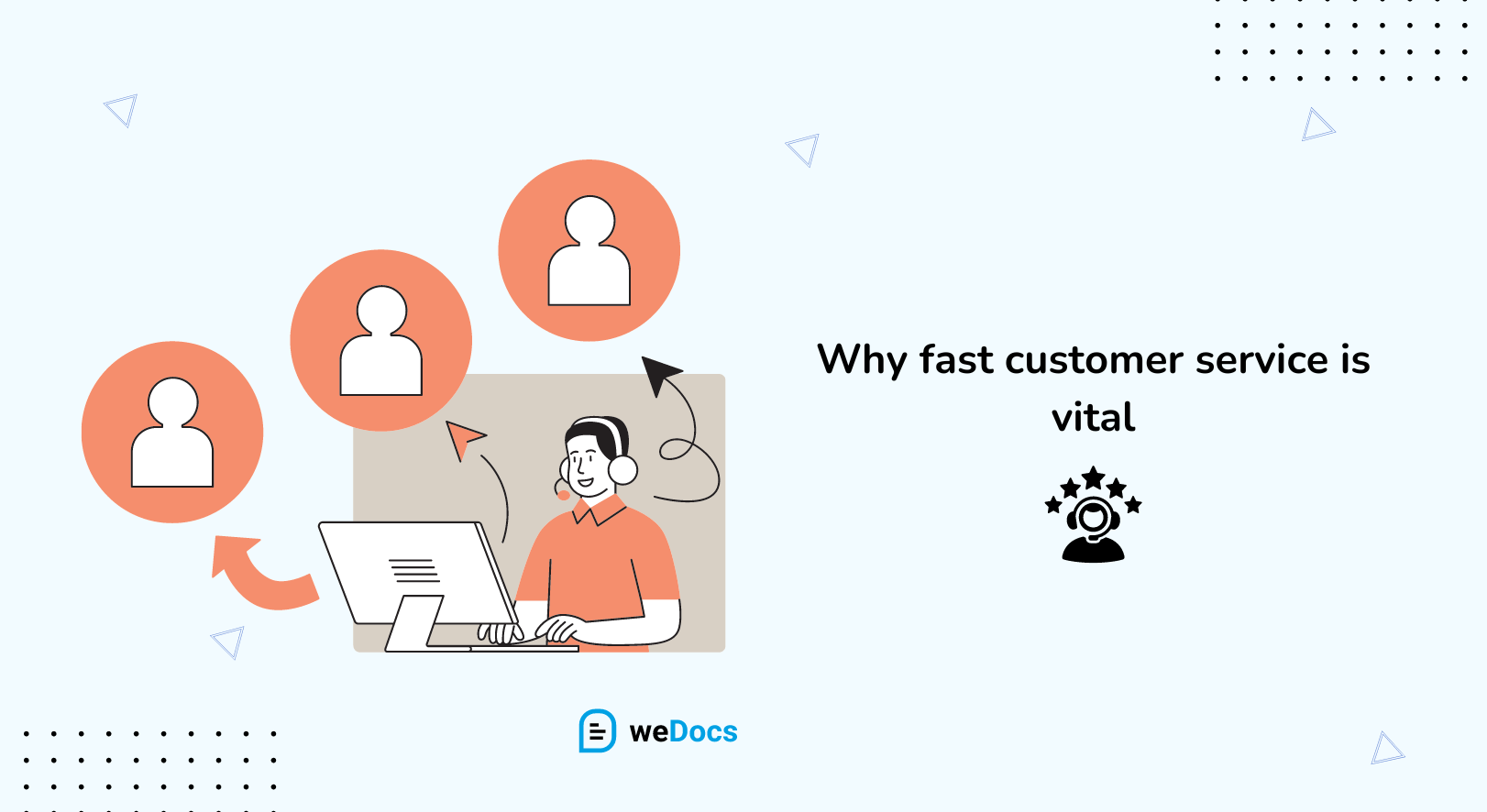
We all know how important is to provide quality customer service. It indicates so many things. Providing good customer service means you’re serious about your customer, their pinpoints, and their queries. What else makes a product or service top-class?
Let’s reveal it from the points below:
a. Boosts customer satisfaction and loyalty
Imagine being on hold for hours or going through endless emails with no resolution. Frustrating, right? According to a Zendesk study, 42% of customers would switch to a competitor after just one bad experience. Fast customer service shows you value their time and concerns. When issues are addressed promptly and efficiently, it cultivates satisfaction and builds trust, turning customers into loyal advocates.
American Express research found that 78% of customers would be willing to do more business with a company if they offered exceptional customer service.
b. Reduces customer churn
Let’s face it, if a customer faces a problem and can’t get timely help, they’re more likely to abandon ship and seek out a competitor who prioritizes their needs. Fast service demonstrates responsiveness and a commitment to resolving issues, reducing customer churn, and fostering long-term relationships. A study by Bain & Company revealed that a mere 5% improvement in customer retention can lead to a profit increase of 75%.
c. Spreads positive Word-of-Mouth marketing
In the age of social media, bad experiences travel fast. But positive ones do too! When customers receive exceptional and speedy service, they’re more likely to share their experience with friends, family, and online networks. According to a report by PwC, 73% of customers say that positive word-of-mouth marketing from friends and family influences their purchase decisions. This organic word-of-mouth marketing is invaluable for attracting new customers and building a brand reputation.
d. Improves brand image
Fast customer service reflects a company that’s professional, efficient, and customer-centric. It positions your brand in a positive light, differentiating you from competitors who may offer slower response times. This can be a deciding factor for customers choosing between similar products or services. Help Scout research indicates that 93% of customers are more likely to make repeat purchases with companies with excellent customer service.
e. Increases sales and revenue
Happy customers are spending customers. By resolving issues quickly and efficiently, you remove roadblocks to purchase and encourage repeat business. Additionally, satisfied customers may even spend more, confident in the knowledge that they’ll receive excellent after-sales support. According to Microsoft research, companies that prioritize customer service see a return on investment (ROI) of $8 for every $1 spent.
f. Improves crisis management
The speed and effectiveness of your customer service response during a crisis can significantly impact how much damage is done to your brand reputation. Fast service allows you to address concerns promptly, take control of the narrative, and minimize negative publicity. This can make the difference between a short-lived hiccup and a long-term brand crisis.
g. Provides valuable customer feedback
Fast customer service interactions open a direct line of communication with your customers. By addressing their concerns quickly, you can gather valuable feedback about their experiences, product issues, and areas for improvement. This real-time feedback allows you to identify and address problems before they escalate and gives you insights to improve your product or service offerings.
h. Boosts employee morale
When empowered to resolve issues efficiently, customer service representatives can significantly improve their morale and job satisfaction. They feel valued and capable, leading to a more positive and productive work environment. This translates into better customer interactions and a stronger overall customer service experience.
10 practical tips to provide fast customer service
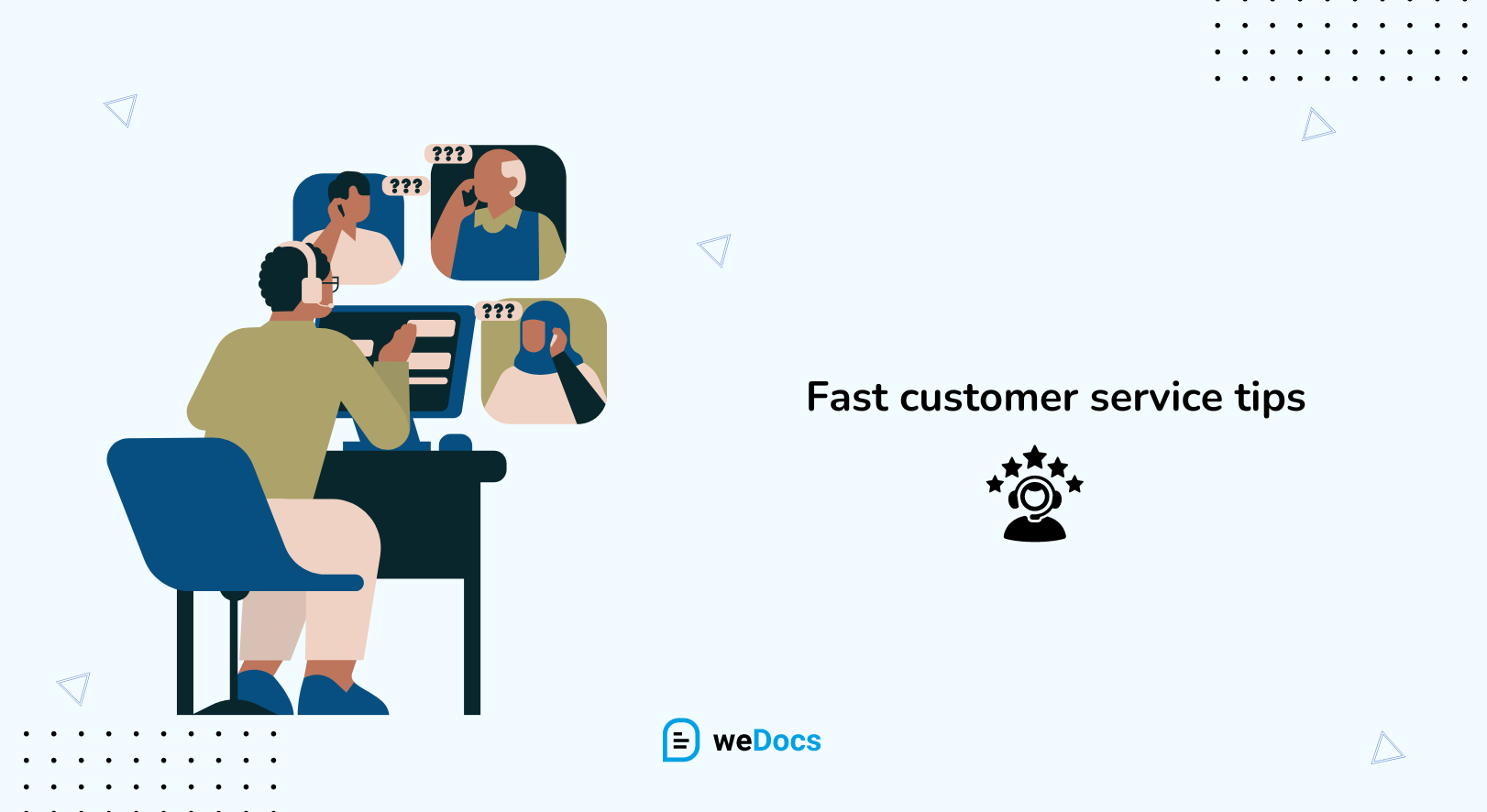
Today, customers expect fast and efficient service. According to a 2023 Zendesk report, 74% of customers expect a response to their inquiry within 24 hours, and 41% of customers abandon a company after just one bad experience. Providing speedy customer service is no longer a nicety; it’s a necessity for business success.
After you have gone through the above customer service principles, let’s add some extra texture with these tips. Once you can combine these, you can then expect to get better outcomes in the end. Here are 10 practical tips to help you deliver speedy and exceptional customer service that keeps your customers happy and coming back for more:
01. Know your product or service first
In-depth knowledge of your company’s products or services is the cornerstone of fast and efficient customer service. Anticipate common customer questions and have solutions readily available. This can be achieved through comprehensive training programs that cover product features, functionalities, troubleshooting steps, and frequently encountered customer issues.
Additionally, empower reps with resources such as knowledge base articles, internal wikis, and cheat sheets for quick reference. Regular product updates and refresher courses are also essential to ensure reps stay current on the latest features and solutions.
Let’s say a customer calls a cable company frustrated that their internet keeps dropping. The service rep quickly identifies the issue as a known problem in their area due to recent maintenance. The rep explains the situation, offers a temporary solution using the mobile hotspot feature, and assures the customer the issue will be resolved within the next few hours.
02. Listen first, then act
Active listening is the foundation of effective communication and is essential for resolving customer issues quickly and efficiently. It involves giving the customer your full attention, both verbally and nonverbally. This means making eye contact (if you’re interacting in person), avoiding interruptions, and using body language that conveys that you’re engaged in the conversation.
Pay close attention to the customer’s words, but also listen for the underlying emotions and frustrations that may not be explicitly stated. Try to paraphrase what you’ve heard to ensure understanding and identify any areas where you may need clarification. This demonstrates that you’re actively following the conversation and shows the customer that you care about their concerns. By truly listening to the customer, you can get to the root cause of the problem faster and develop a more targeted solution.
A customer contacts a music streaming service’s online chat support because they can’t download any songs for offline listening. The rep actively listens, clarifies that the issue is specific to their downloaded playlist, and guides the customer through the steps of clearing the app cache and restarting the app. This resolves the issue, and the customer can download their playlist for offline listening.
03. Leverage technology for efficiency
Consider utilizing knowledge-based articles, frequently asked questions (FAQs), and automated chatbots to address basic questions and deflect simple inquiries. This will allow your representatives to concentrate on more complex issues that require human intervention. For instance, when a customer has a simple question about return policies, a well-designed chatbot can answer their question immediately, freeing up agents for more complex issues.
Additionally, implementing self-service portals where customers can access account information, track orders, download manuals, and troubleshoot common problems independently can greatly enhance the customer experience. These self-service options empower customers to find solutions quickly and conveniently, reducing resolution times and improving overall customer satisfaction.
Here are the benefits of using technology to streamline customer service:
- Reduced wait times: By deflecting simple inquiries to automated systems, customers can get answers to their questions quickly without waiting on hold for a live representative.
- Improved agent productivity: When reps aren’t bogged down with basic questions, they can dedicate more time to resolving complex customer issues that require a human touch.
- Increased customer satisfaction: Customers appreciate the ability to find answers and resolve issues on their own time, leading to higher satisfaction levels.
- 24/7 availability: Self-service options are available to customers anytime, anywhere, regardless of business hours.
04. Prioritize smartly and triage for efficiency
Companies that prioritize customer service effectively see a 73% improvement in customer retention
Forrester Research
Not all customer issues are created equal. Develop a system to categorize incoming requests by urgency and complexity. This allows agents to prioritize critical issues that require immediate attention, like service outages, while addressing other inquiries promptly.
Imagine a busy customer service department receiving a constant stream of emails, chats, and calls. Some customers might have a critical issue preventing them from using your product entirely, while others might have minor questions.
By doing so, you can:
- Reduce wait times: Customers with urgent problems get help faster, leading to higher satisfaction.
- Optimize agent workload: Agents can focus on resolving high-impact issues first, improving overall efficiency.
- Identify trends: By analyzing triage data, you can identify recurring problems and proactively address them, preventing future issues.
05. Streamline processes to eliminate unnecessary steps
Businesses that excel at customer experience see a 6% to 8% increase in customer lifetime value
Bain & Company
Take a critical look at your customer journeys and identify bottlenecks that slow down the resolution process. Automate repetitive tasks wherever possible. For instance, a customer requesting a refund for a returned item can be met with frustration if the process is manual and requires agent intervention.
Imagine a customer contacting support because they can’t reset their password. In an unstreamlined process, they might need to navigate a complex phone menu, wait on hold for an extended period, and then repeat their issue to an agent. This is frustrating for both the customer and the agent.
Streamlining eliminates these redundant steps, leading to several benefits:
- Faster resolution times: Customers get help quicker, reducing their frustration and wait times.
- Improved agent productivity: Agents spend less time on repetitive tasks and more time resolving complex issues.
- Reduced costs: Streamlining can save money by optimizing resource allocation and minimizing wasted time.
- Enhanced customer satisfaction: Faster resolutions and a smoother experience lead to happier and more loyal customers.
06. Keep customers informed to manage expectations
Communication is key to managing customer satisfaction. Always provide accurate estimated wait times, whether it’s for phone calls, emails, or live chat interactions. Additionally, offer periodic updates on the progress of their issue. This transparency builds trust and prevents customers from feeling ignored or forgotten while waiting for a resolution.
73% of customers feel more loyal to brands that listen to their feedback and take action
Microsoft
Customer contacts support about a reported bug in your mobile app. They receive no updates after submitting their request. Days later, they still haven’t heard anything, leaving them frustrated and unsure when the issue will be fixed.
By keeping them informed, you can:
- Reduce anxiety and frustration: Regular updates, even if there’s no immediate solution, let customers know their issue is acknowledged and being addressed.
- Manage expectations: Setting realistic timelines for resolution helps customers plan accordingly and avoid disappointment over unexpected delays.
- Build trust and transparency: Open communication demonstrates that you value their time and business.
07. Empower your representative to make a better decision
Empower your agents to be problem-solvers, not just information providers. Equip them with the knowledge and authority to resolve issues independently without excessive escalation. Set clear guidelines for offering solutions and handling refunds within a reasonable range.
Think about a customer contacting support about a complex billing issue. The agent, lacking decision-making authority, needs to escalate the issue to a supervisor, delaying resolution and potentially frustrating the customer. Empowering agents allows them to:
- Resolve Issues Faster: Agents can address problems on the spot without waiting for supervisor approval, leading to quicker resolutions and happier customers.
- Build Stronger Customer Relationships: Empowered agents can offer personalized solutions and demonstrate a genuine commitment to customer satisfaction.
- Boost Agent Morale and Confidence: Trusting agents to make decisions fosters a sense of ownership and increases job satisfaction.
This empowers agents to take ownership of customer issues and offer faster resolutions. For example, an agent can offer a discount or waive a fee to resolve a customer complaint without needing the manager’s approval. This not only empowers the agent but also creates a faster and more satisfying experience for the customer.
08. Get a multi-channel customer support agent
Customers today expect to connect with businesses through their preferred channels. Offer support across multiple channels like phone, email, live chat, and social media. Ensure a seamless experience, regardless of the chosen channel. Customers who reach out on social media about a billing issue shouldn’t be directed to call a phone number.
73% of customers value the ability to reach a company through their preferred channel
PwC
Customers prefer to communicate via email for complex issues, while others prefer a quick live chat for simple questions. A traditional, single-channel approach might leave some customers frustrated and unable to get the support they need on their preferred platform.
Multi-channel support offers several advantages:
- Increased customer satisfaction: Customers can choose the communication method that best suits their needs and preferences.
- Improved accessibility: Reaching support becomes easier for customers with different communication styles or time zone limitations.
- Enhanced efficiency: Agents can leverage the strengths of each channel to optimize workflow and handle inquiries effectively.
Having multi-channel support allows agents to address the issue directly through that platform, providing a faster and more convenient resolution.
09. Foster a culture of ownership
Building a customer-centric culture goes beyond just resolving issues. Encourage agents to take ownership of customer concerns and resolve them. Recognize and reward proactive problem-solving and excellent customer service.
Customer service department, where agents view themselves as order takers, simply following a script. This approach can lead to a lack of engagement and a disconnect from customer needs.
A culture of ownership, on the other hand, brings several benefits:
- Improved customer satisfaction: Agents become invested in finding solutions and exceeding customer expectations.
- Enhanced problem-solving: Ownership encourages proactive thinking and creative solutions to complex customer issues.
- Increased employee engagement: Feeling empowered and valued fosters job satisfaction and reduces turnover.
- Stronger team spirit: A shared sense of responsibility fosters collaboration and a supportive work environment.
This fosters a sense of accountability and motivates agents to go the extra mile for customers consistently. Imagine an agent researching a customer’s issue and discovering a similar issue affecting other customers. They could proactively reach out to those customers, saving them time and frustration. This not only delights the initial customer but also prevents further issues, demonstrating a commitment to exceptional service.
- Research the issue to gain a deeper understanding
- Develop a short tutorial video explaining the feature clearly and engagingly
- Proactively reach out to the customer with the video and offer additional support
10. Continuously improve: gather feedback and analyze
Your journey to fast customer service is never truly finished. Actively collect customer feedback through surveys and follow-up emails. Analyze this data to identify areas for improvement, such as long wait times or a lack of knowledge base articles. Based on these insights, implement changes to continuously improve your customer service processes.
Report shows that companies that prioritize customer feedback see a 10% increase in customer loyalty
Qualtrics XM Institute
Imagine a customer service team relying on outdated processes and strategies. Customer needs and expectations evolve, and a static approach can quickly lead to frustration and dissatisfaction. By continuously gathering feedback and analyzing it, you can:
- Identify pain points: Uncover areas where your customer service experience falls short and prioritize improvements.
- Meet evolving needs: Adapt your strategies to keep pace with changing customer expectations and preferences.
- Measure progress: Track the effectiveness of implemented changes and identify areas for further refinement.
For instance, customer feedback might reveal long wait times for email support. The company can then analyze staffing needs and implement solutions to reduce wait times. By actively seeking and utilizing customer feedback, you can ensure your customer service system remains efficient and responsive to evolving needs.
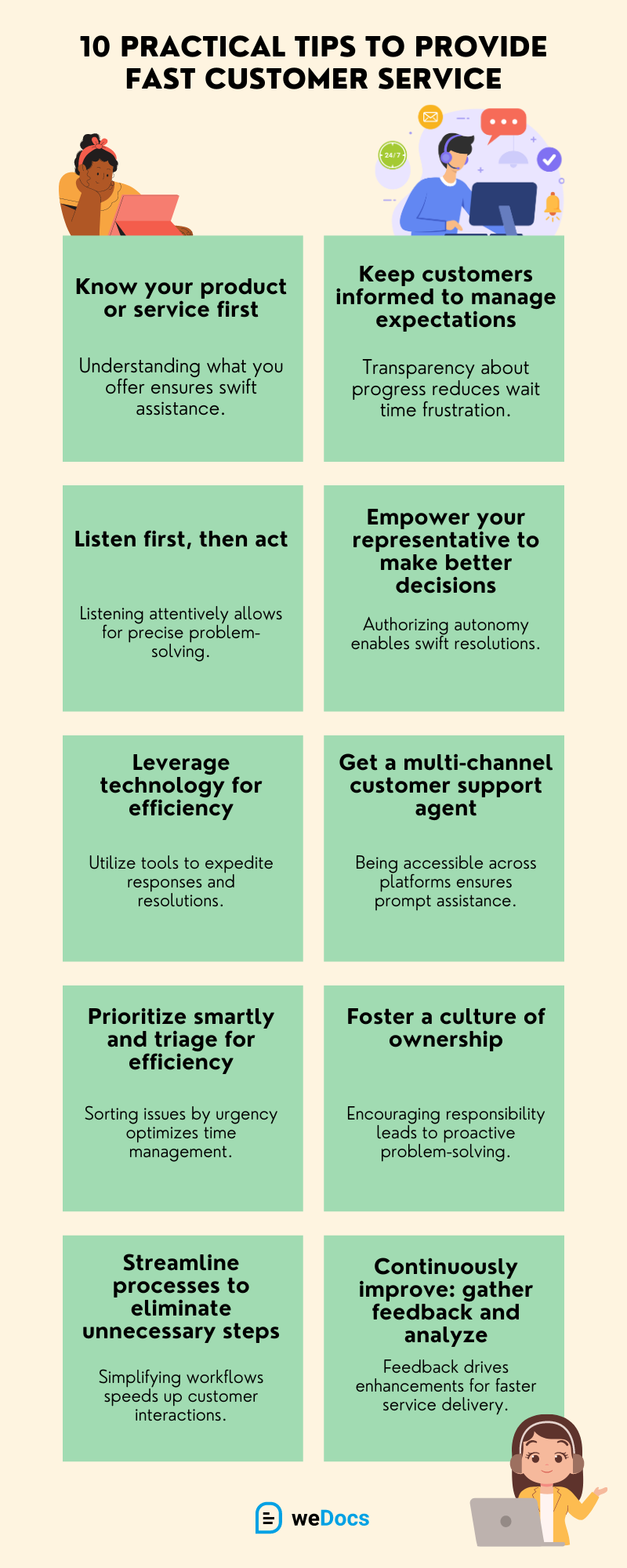
Bonus: Are there any benefits to training the support team for better customer support
Research by Zendesk shows that 89% of consumers say a positive customer experience is important to their buying decisions. Also, speed is a key component in increasing customer happiness. On this matter, Salesforce also shared information. They said 42% of customers expect a response to their service inquiries within 60 minutes.
So here is why training your support team for fast customer service is crucial:
a. Increased customer satisfaction
The faster you resolve customer issues, the happier they’ll be. Studies show that 73% of customers base their loyalty on how a company handles complaints. A well-trained team can quickly understand problems and offer solutions, minimizing customer frustration.
b. Improved customer retention
Speedy service keeps customers coming back. Reducing customer service resolution time by just 5% can increase customer retention by 5% to 10%. By resolving issues quickly, you demonstrate your commitment to customer satisfaction, fostering brand loyalty.
c. Enhanced brand reputation
Fast and efficient customer service builds trust and a positive brand image. Positive online reviews generated from swift issue resolution can significantly influence future customer decisions.
d. Boosted employee morale
A team equipped to handle inquiries efficiently experiences less stress and frustration. Training empowers them to solve problems independently, leading to a greater sense of accomplishment and job satisfaction.
e. Increased efficiency and productivity
By streamlining processes and equipping agents with the knowledge to resolve issues quickly, you minimize wasted time and resources. This allows your team to handle a higher volume of inquiries while maintaining a high level of service.
f. Cost savings
Faster resolution times translate to lower customer service costs. Reducing average handling time by 10% can lead to a 10% to 30% decrease in costs.
How weDocs can help you boost customer support

weDocs is the most prominent documentation management solution for WordPress users. Considering the user’s demand and requirements, weDocs was revamped last year with a newer version weDocs 2.0 or weDocs Pro. This time we have added some super cool features to lessen the hassle of theme and plugin owners.
Features like:
- Easy documentation creation: You can create, edit, delete, and update any documentation for your products.
- User-friendly drag-and-drop feature: Gone are the days to follow traditional functions for creating a knowledge base. Just use the drag-drop feature. That’s all, your docs are ready to use.
- Powerful search functionality: Users can find relevant documentation with the in-built search option.
- Multilingual support: Different users from different areas can access your documentation with multilingual support.
- Customizable themes and templates: You can display and customize your documentation template with weDocs.
- Easy permission management: Grand access to your most important person role-wise. Also, you can hide your important documentation from the selected users.
- Migration feature: If you’re using other documentation solutions, then the migration feature can help to transfer your data to weDocs.
- weDocs ChatGPT AI Chatbot-powered Assistant Widget for automated support: People love less effort these days to reach out to customers. For instance, weDocs introduced an AI chatbot-powered assistant widget to help users, in this case.
- And more…
These options are handy for any plugin or theme owners to prepare their knowledge base. So we can say weDocs is a compact solution as a helpful tool for customer service reps.
Final Words
So that’s all in today’s post. We hope you find this post helpful. Try to follow the tricks and tips we have shared. The most important fact that we want to focus on again is training the support team about your product. It will minimize 50% of your entire task. Then follow the rest.
Here’s the recap:
- Product knowledge
- Listen first and then act
- Leverage technology
- Smartly prioritize customer’s query
- Eliminate unwanted steps
- Expectation management
- Train your support team
- Embrace multi-channel technology
- Gather feedback for the betterment
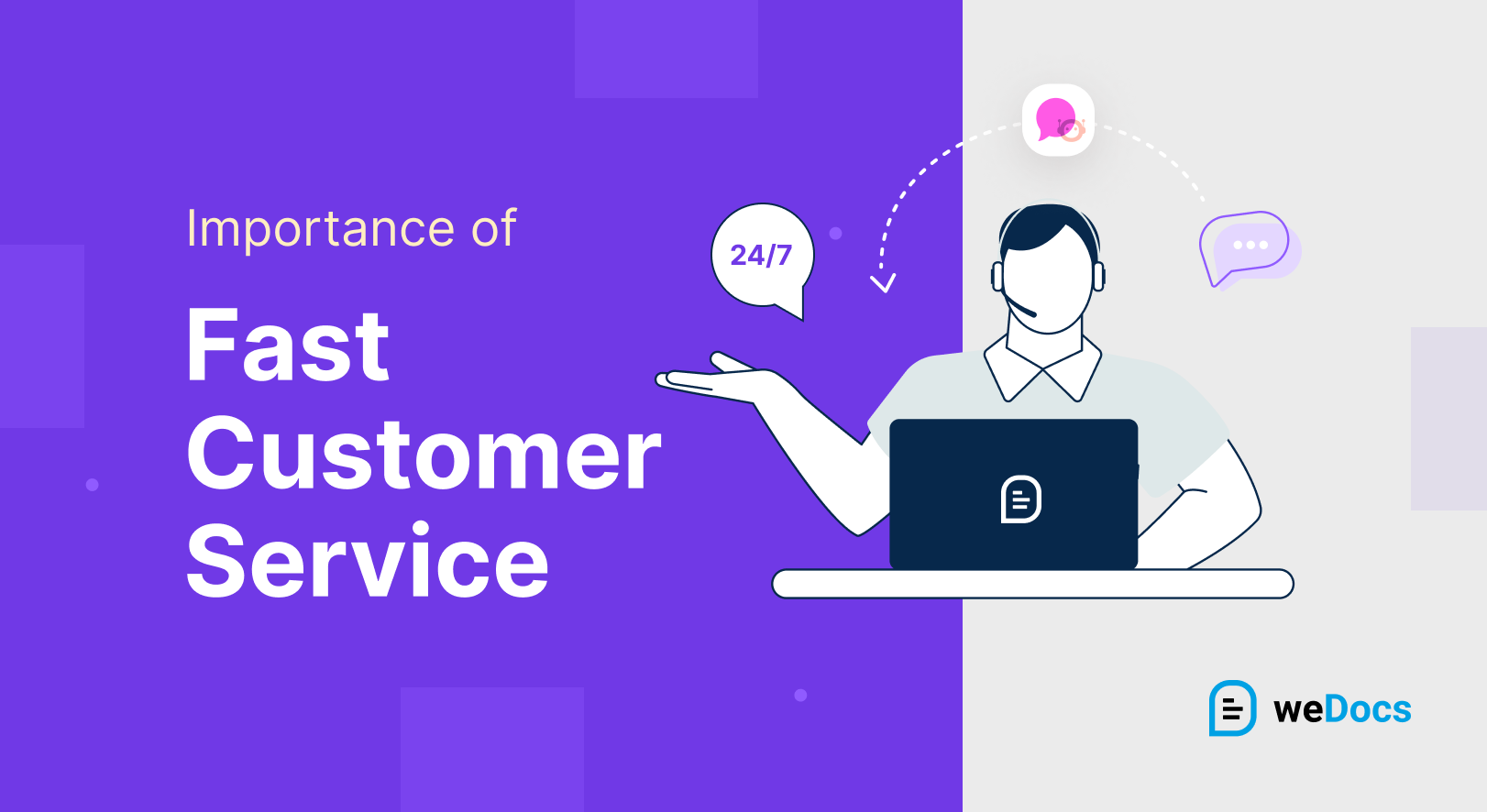
Add your first comment to this post